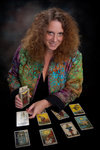Medieval Cat Tarot Review
Tarot World Magazine
Tarot Deck Review
January 2008 Edition
Medieval Cat Tarot
By Lawrence Teng
Review by Christiana Gaudet
Copyright © 2007
Unlike many of my Tarot friends, I don’t go to renaissance faires and I don’t have cats. And so I might have entirely missed the Tarot gem that is Medieval Cat Tarot if it weren’t for two things. First, a Tarot student told me that her readings improved after she started working with this deck. Then, I discovered that the Little White Book is co-authored by Gina M. Pace, author of the Pagan Tarot. I couldn’t imagine that either my student or Gina Pace would embrace a trite deck. And, as it turns out, they didn’t! Medieval Cat Tarot has enough beauty, mysticism, humor and all-over-good-Tarot-vibes to excite me, even though I usually shy away from cute decks that show animals in costume.
Medieval Cat Tarot is published by U.S. Games, and was released in 2004. At 4 ½” by 2 1/2” the cards are noticeably more narrow than most. Somehow, this adds to the medieval feel of the deck. The coloring, too, is a huge part of the deck’s personality. Both back and front of the cards are covered with flourishes in shades of brown, gold and yellow. Rather than looking dull or dark, it looks royal and antique.
The quality of the deck is standard for U.S. Games, the card finish is glossy and the deck comes in the old packaging format with just the Little White Book. Gina M. Pace, along with Tarot artist Lawrence Teng, has written an LWB worth reading. It’s a lot of good information in a small space, and certainly suitable for a beginner.
One of the most interesting aspects of this deck, other than its peculiar subject matter, is that the pips are designed in the Marseilles style, where each card shows simply the appropriate number of suit icons. But in the center of each card is an oval, with a picture of a cat in action. Thus, the Medieval Cat Tarot has achieved something that many other decks have tried to do less successfully. It has combined the meditative and intuitive grace of the Marseilles style with the artistry and vision of the Waite style.
These little cat pictures remind me of windows into another world; a world where cats walk upright and wear elaborate medieval garb. The pictures are simple, but with interesting detail and symbolism. Once again, the use of color is stunning. Spots of blue, red and yellow simply shine against the dark background.
Many of the cats are shown in basic Waite-style poses. Some of them, however, portray the Waite ideas but make specific reference to cat life. For instance, the Five of Coins shows a sad kitty stuck in a tree in the rain. The Seven of Swords shows the cat who (you guessed it!) ate the canary.
The Court ranks are traditionally named. Of the Court cards, the Kings are my favorite. The King of Swords sits in front of a windmill. The King of Cups sits in front of a water wheel. Beginners will find these kinds of elemental clues helpful, and experienced readers will be charmed by them.
The Major Arcana is also reminiscent of the Marseilles Tarot, except, of course, that all the characters are cats! There are a few other notable breaks from tradition. The Hanged Man, for instance, is hanging from an arm and a leg, instead of just the leg.
Death is one of my favorite cards in this particular deck. The image shows a skeletal cat as the hooded reaper with his scythe. But the scythe curves over the horizon to become a crescent archway. Under the archway, surrounding the death figure, fly dozens of butterflies.
The only cards in the deck that don’t captivate me are the Aces. Each Ace shows its suit icon and an animal related to its element, but no cats! The animals that are shown are not clothed as the cats. Instead, they are realistic wild animals. The Wand has a lizard, the Sword has two birds, the Cup has two fish and the Pentacle has mice. The LWB describes the animals and what they symbolize, but there is no mention of why the Aces are the only cards to break away from the theme of the deck. I can’t help but think that the kitties would want to catch and eat all the Aces!
The cats that grace the other seventy-four cards have sweet and simple faces that are filled with expression. With just a few lines Lawrence Teng can show palpable emotion. The costumes on the cats don’t seem out of place at all, and are lovely to look at. I can’t help thinking that Mr. Teng’s cats would have gotten along well with Beatrix Potter’s animal friends.
Medieval Cat Tarot is a fun and easy deck for beginners. It is also a fine deck for professional readers, especially when reading at a public event or for a jittery client. None of the images are disturbing in any way, and the deck is both pretty and unusual enough to be a conversation piece.
As a whole, Tarot often asks us to step outside of our mental boxes and look at things in a different way. We are asked to stretch our faith, our vision and our understanding. Medieval Cat Tarot helped me to stretch into an imaginary realm in which I thought I would have no interest. But, as is often true with Tarot, if we stretch, we find parts of ourselves we didn’t know we had. Maybe I’ll see you next year at the Renaissance Faire!

